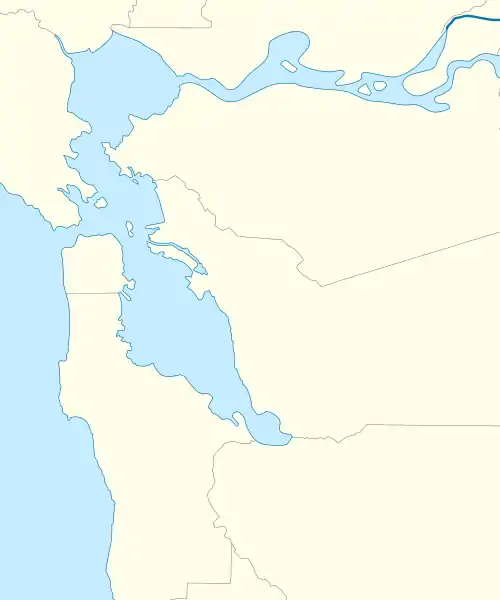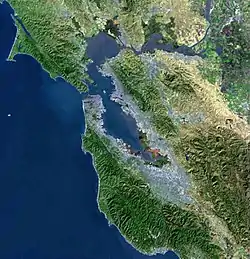Hooks Island
Hooks Island is an approximately 36-acre (15 ha)[1] tidal salt marsh island[2] in the San Francisco Bay, in the city of Palo Alto, California, United States. It is home to members of several endangered species, as well as five transmission towers (belonging to the Ravenswood-Ames 115kV transmission line). It is described in a 2020 Santa Clara Valley Water report as an "undisturbed tidal salt marsh" consisting partly of an "estuarine intertidal emergent wetland".[1] Its northern tip, located at 37°27′30″N 122°05′49″W, is known as Hooks Point.[3] Hooks Island is located directly east of the Palo Alto Baylands Sailing Station.
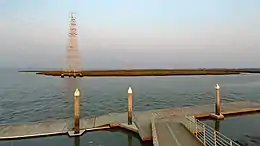 Hooks Island as viewed from the Palo Alto Baylands Sailing Station in September 2020 | |
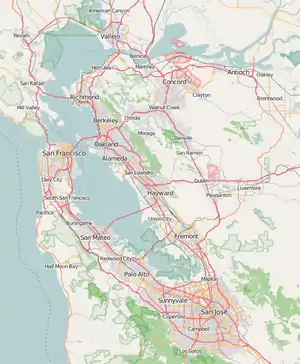 Hooks Island 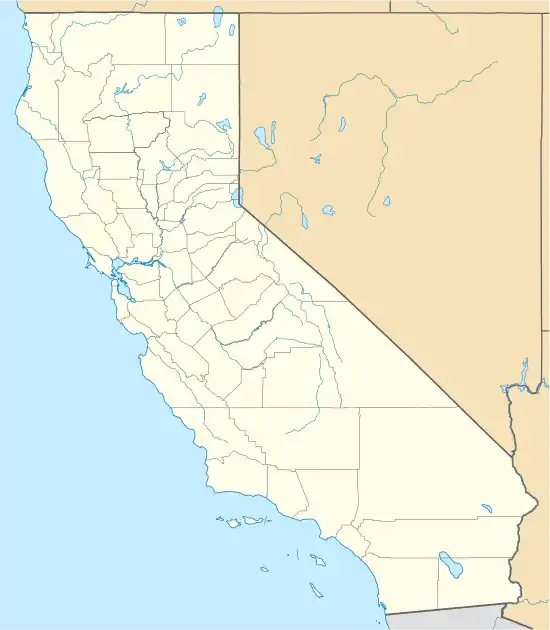 Hooks Island  Hooks Island | |
| Geography | |
|---|---|
| Location | Northern California |
| Coordinates | 37°27′22″N 122°05′51″W |
| Adjacent bodies of water | San Francisco Bay |
| Total islands | 1 |
| Area | 36[1] acres (15 ha) |
| Administration | |
United States | |
| State | |
| County | Santa Clara |
| City | Palo Alto |
As part of the Palo Alto Baylands Nature Preserve, Hooks Island is a protected area, and local governments prohibit humans from traveling to it;[4] like many parts of the San Francisco Bay area, development (especially of housing) is not permitted.[5][6]
Flora
As is common on large areas of ground, grass grows on Hooks Island. Specifically, several species of cord grass provide a habitat for various animals. In 1997, a study discovered that the native cord grass, Spartina foliosa, was being displaced on Hooks Island by the invasive species Spartina alterniflora, which "grows denser than the native species and makes it harder for animals to move around".[7]
The S. alterniflora, originally introduced to the area in 1973 by an Army Corps of Engineers project to control erosion and restore marshes in the Bay, hybridized with native cord grasses, forming dense growth aboveground and a dense root system, which displaced both surface dwellers and animals that lived beneath the mud.[8]
When the 1973 attempt to reverse damage to the marshes was eventually found to be harmful for wildlife, it was itself reversed—the California Coastal Conservancy's San Francisco Estuary Invasive Spartina Project was able, with the aid of the herbicide imazapyr as well as physical removal methods, to heavily reduce the overall footprint of S. alterniflora growth across a 70,000-acre "work area", from 805 acres in 2005 to 28 acres in 2016 (at which point $30 million had been spent).[8]
While this project was a "resounding success", federal officials required the conservancy to reverse part of their reversal of the initial reversal, after it was found that the (then-endangered) California clapper rail had taken up residence in thickets of the invasive species.[9][8]
Fauna
Numerous birds have been known to live on Hooks Island, such as the near-threatened[10] California clapper rail. In 2011, a Point Reyes Bird Observatory Conservation Science report found that approximately 14 clapper rails had been found in the Baylands, and 19 clapper rails were "known to exist" at Palo Alto Harbor and Hooks Island.[11] Other estimates of the total Baylands population in 2011 included "approximately 15–29 individuals".[2] However, in 2010, there had been as many as 22 clapper rails.[11] In 2013, allegations were made that feral cats were living on Hooks Island and killing them.[11] While it is broadly accepted that there are many cats in the San Francisco Bay area,[12] the extent of their presence in the Palo Alto Baylands (and of their role in the killing of clapper rails) was disputed. While the city's division manager of open space, parks and golf claimed to have "personally seen feral cats hunt and catch birds in the Baylands Nature Preserve", a volunteer at the Palo Alto Humane Society offered a rejoinder to this claim, stating that "compared to people, the damage feral cats do is minor".[11]
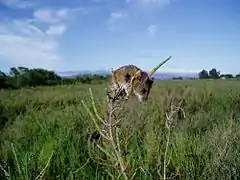 The salt marsh harvest mouse can survive only in the vegetation of salt marshes.
The salt marsh harvest mouse can survive only in the vegetation of salt marshes..jpg.webp) The clapper rail majestic.
The clapper rail majestic.
See also
- List of California Department of Fish and Game protected areas
- List of islands of San Francisco Bay
- Salt marsh harvest mouse
References
- "Palo Alto Flood Basin Tide Gate Structure Replacement Project" (PDF). Santa Clara Valley Water. September 2020. p. 42. Retrieved 15 September 2020.
- Petra Unger; Diana Edwards (December 2017). Palo Alto Baylands: Existing Conditions (Report). AECOM, 2020 L Street, Suite 400, Sacramento, CA 95811. Retrieved 15 September 2020.
- "GNIS Detail – Hooks Point". U.S. Geological Survey Geographic Names Information System. 9 April 1999. Retrieved 15 September 2020.
- "San Francisco Bay Area Water Trail: Site Description for Palo Alto Baylands Sailing Station" (PDF). California State Coastal Conservancy. 29 May 2012. Retrieved 15 September 2020.
Boat users need to be sensitive to wildlife, high tide refugia, and marsh habitat, observe buffer distances, and not land in any location besides the Sailing Station, including Hooks Island, located across from the Sailing Station. Additionally, there are areas located nearby where a boater who lands inappropriately could disturb nesting Western burrowing owls (Mountain View) or Western snowy plovers (Alviso or Ravenswood). The City of Palo Alto Municipal Code prohibits trampling vegetation and/or harassing wildlife and non‐permitted activities in the marsh constitute violations and are subject to fines of $1,000 or more
- "Palo Alto Open Space". City of Palo Alto. Retrieved 15 September 2020.
- "History of Baylands Nature Preserve". City of Palo Alto. 1 June 2007. Retrieved 15 September 2020.
- Dremann, Sue (1 November 2013). "Saving the Baylands: Scientists, nonprofit groups work to protect Palo Alto marshlands". Palo Alto Online. Retrieved 15 September 2020.
- Rogers, Paul (17 April 2016). "San Francisco Bay: Massive effort to remove aquatic invader nearly finished". The Mercury News. Bay Area News Group. Retrieved 15 September 2020.
- Poor, William (7 August 2018). "This monster plant is taking over Silicon Valley—should we let it?". The Verge. Retrieved 15 September 2020.
- BirdLife International (2016). "Rallus obsoletus". IUCN Red List of Threatened Species. 2016. Retrieved 15 September 2020.
- Dremann, Sue (14 September 2013). "Wildlife experts: Cats are killing Baylands wildlife". Palo Alto Weekly. Retrieved 15 September 2020.
- Eslinger, Bonnie (14 November 2013). "East Palo Alto man says city is a dumping ground for feral cats". The Mercury News. San Mateo County Times, Bay Area News Group. Retrieved 15 September 2020.
